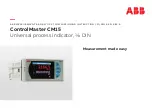
NOTE: You cannot remove MAC addresses if they are active on the node or are assigned to a profile.
To remove MAC addresses from the network share:
1.
Go to the
Server Profiles
page. In the
Boot Identity Profiles
→
Manage Virtual MAC Address Pool
section, click
Remove
MAC Addresses
.
2.
Enter the starting MAC address of the MAC address pool in the
Starting MAC Address
field.
3.
Enter the count of the MAC addresses that you want to remove, in the
Number of MAC Addresses
field.
4.
Click
OK
to remove MAC addresses.
Deactivating MAC Addresses
You can deactivate MAC addresses that are active by using the
Deactivate MAC Address(es)
option in the CMC web interface.
NOTE: Use the Deactivate MAC Address(es) option only if the server is not responding to the Clear Identity action or the
MAC address is not used in any server.
To remove MAC addresses from the network share:
1.
Go to the
Server Profiles
page. In the
Boot Identity Profiles
→
Manage Virtual MAC Address Pool
section, select the active
MAC address(es) that you want to deactivate.
2.
Click
Deactivate MAC Address(es)
.
Launching iDRAC using Single Sign-On
CMC provides limited management of individual chassis components, such as servers. For complete management of these individual
components, CMC provides a launch point for the server’s management controller (iDRAC) web-based interface.
A user may be able to launch iDRAC web interface without having to log in a second time, as this feature utilizes single sign-on.
Single sign-on policies are:
•
A CMC user who has server administrative privilege, is automatically logged in to iDRAC using single sign-on. Once on the iDRAC
site, this user is automatically granted Administrator privileges. This is true even if the same user does not have an account on
iDRAC, or if the account does not have the Administrator’s privileges.
•
A CMC user who does
NOT
have the server administrative privilege, but has the same account on iDRAC is automatically logged
in to iDRAC using single sign-on. Once on the iDRAC site, this user is granted the privileges that were created for the iDRAC
account.
•
A CMC user who does not have the server administrative privilege, or the same account on the iDRAC, is not automatically
logged in to iDRAC using single sign-on. This user is directed to the iDRAC login page when the
Launch iDRAC GUI
is clicked.
NOTE: The term "the same account" in this context means that the user has the same login name with a matching
password for CMC and for iDRAC. The user who has the same login name without a matching password, is considered to
have the same account.
NOTE: Users may be prompted to log in to iDRAC (see the third Single Sign-on policy bullet above).
NOTE: If the iDRAC network LAN is disabled (LAN Enabled = No), single sign-on is not available.
If you click
Launch iDRAC GUI
, an error page may be displayed, if:
•
the server is removed from the chassis
•
the iDRAC IP address is changed
•
the iDRAC network connection experiences a problem.
In MCM, while launching the iDRAC web interface from a member chassis, the user credentials of the leader and member chassis
must be the same. Else, the current member chassis session is aborted and the member chassis login page is displayed.
106
















































